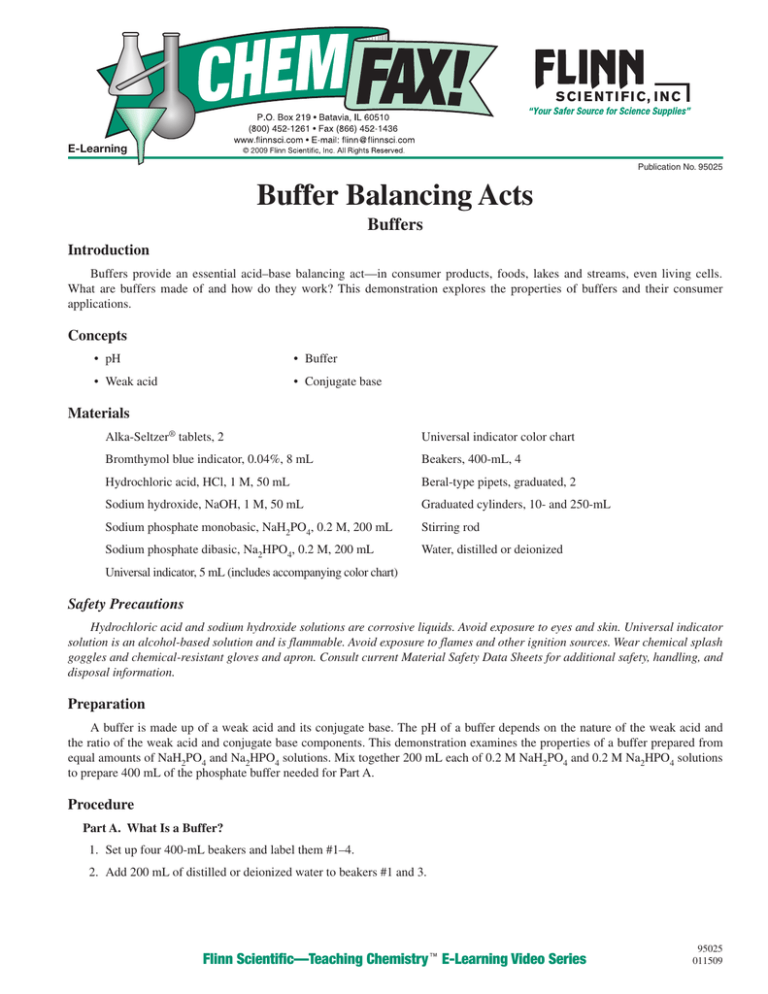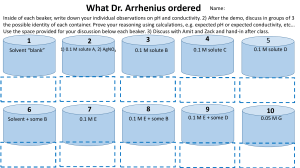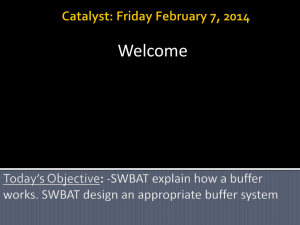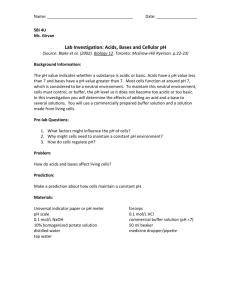
E-Learning
2009
Publication No. 95025
Buffer Balancing Acts
Buffers
Introduction
Buffers provide an essential acid–base balancing act—in consumer products, foods, lakes and streams, even living cells.
What are buffers made of and how do they work? This demonstration explores the properties of buffers and their consumer
applications.
Concepts
• pH
• Buffer
• Weak acid
• Conjugate base
Materials
Alka-Seltzer® tablets, 2
Universal indicator color chart
Bromthymol blue indicator, 0.04%, 8 mL
Beakers, 400-mL, 4
Hydrochloric acid, HCl, 1 M, 50 mL
Beral-type pipets, graduated, 2
Sodium hydroxide, NaOH, 1 M, 50 mL
Graduated cylinders, 10- and 250-mL
Sodium phosphate monobasic, NaH2PO4, 0.2 M, 200 mL
Stirring rod
Sodium phosphate dibasic, Na2HPO4, 0.2 M, 200 mL
Water, distilled or deionized
Universal indicator, 5 mL (includes accompanying color chart)
Safety Precautions
Hydrochloric acid and sodium hydroxide solutions are corrosive liquids. Avoid exposure to eyes and skin. Universal indicator
solution is an alcohol-based solution and is flammable. Avoid exposure to flames and other ignition sources. Wear chemical splash
goggles and chemical-resistant gloves and apron. Consult current Material Safety Data Sheets for additional safety, handling, and
disposal information.
Preparation
A buffer is made up of a weak acid and its conjugate base. The pH of a buffer depends on the nature of the weak acid and
the ratio of the weak acid and conjugate base components. This demonstration examines the properties of a buffer prepared from
equal amounts of NaH2PO4 and Na2HPO4 solutions. Mix together 200 mL each of 0.2 M NaH2PO4 and 0.2 M Na2HPO4 solutions
to prepare 400 mL of the phosphate buffer needed for Part A.
Procedure
Part A. What Is a Buffer?
1. Set up four 400-mL beakers and label them #1–4.
2. Add 200 mL of distilled or deionized water to beakers #1 and 3.
Flinn Scientific—Teaching Chemistry E-Learning Video Series
95025
011509
3. Add 200 mL of the phosphate buffer to beakers #2 and 4.
4. Add about 2 mL of bromthymol blue indicator to each beaker. (The solutions should all be green. This is the “neutral”
color of the indicator, corresponding to pH values between 6 and 7.6.)
5. Add 10 drops of 1 M HCl to beaker #1. (Note the color change to yellow. This is the “acidic” color of the indicator.)
6. Add 10 drops of 1 M HCl to beaker #2. (No color change—solution stays green.)
7. Add an extra 10 drops of 1 M HCl to beaker #2. (Still no color change. Look frustrated!)
8. Use a graduated cylinder to add 5 mL of 1 M HCl to beaker #2. (The frustration mounts as the solution remains green.)
9. Continue adding 1 M HCl in 5-mL increments until the color changes to yellow. (This will probably take 2–3 more 5-mL
portions of HCl, for a total of 15–20 mL.)
10. Discuss the behavior of the buffer with respect to excess strong acid. What will happen if strong base is added?
11. Add 10 drops of 1 M NaOH to beaker #3. (Note the color change to blue. This is the “basic” color of the indicator.)
12. Add 10 drops of 1 M NaOH to beaker # 4. (No color change—solution stays green.)
13. Add an extra 10 drops of NaOH to beaker #4. (Still no color change—but you are not surprised!)
14. Add 5 mL of 1 M NaOH to beaker #4. (The solution remains green.)
15. Continue adding 1 M NaOH in 5-mL increments until the color changes to blue. (This will probably take 2–3 more 5-mL
portions of NaOH, for a total of 15–20 mL.)
16. Pour the solutions down the drain with plenty of excess water and rinse the beakers with distilled or deionized water for
use in Part B.
17. Invite student discussion to come up with a working definition of a buffer. (A buffer is a solution prepared from a weak
acid and its conjugate base that resists pH changes upon addition of strong acid or base.)
Part B. Buffer Action in a Consumer Product
1. Set up four clean beakers and relabel them #1–4, if necessary.
2. Add 200 mL of distilled or deionized water to each beaker.
3. Dissolve one Alka-Seltzer tablet in each beaker #2 and 4.
4. Read the label on the Alka-Seltzer tablet and note the principal ingredients listed. Are there any weak acids and weak bases
present that are capable of forming a buffer? (The active buffer ingredients are citric acid and sodium bicarbonate.)
5. Add about 20 drops (1 mL) of universal indicator solution to each beaker #1–4. Note the color of each solution and use the
color chart to estimate the initial pH of each solution. (The solutions should all be yellow-green, pH 6–7. If the water in the
control beakers #1 and 3 is not yellow–green, add 1–2 mL of pH 7 buffer.)
6. Add 1 mL of 1 M HCl to beakers #1 and 2. Compare the indicator color and pH of each solution. (Water will turn red,
indicating a pH ≤ 4. The Alka-Seltzer solution should stay green, pH 6–7, suggesting that it is acting as a buffer.)
7. Continue adding 1 M HCl in 1-mL increments to the Alka-Seltzer solution in beaker #2 until the indicator color is the
same as that in beaker #1. How much acid must be added to overwhelm the buffer capacity of one Alka-Seltzer tablet?
(This will probably take about 20 mL of 1 M HCl.)
8. Relate the acid-neutralizing ability of Alka-Seltzer to the definition and uses of antacids.
9. Add 1 mL of 1 M NaOH to beakers #3 and 4. Compare the indicator color and pH of each solution. (Water will turn purple, indicating a pH ≥ 10. The Alka-Seltzer solution should stay green, pH 6–7, suggesting that it acts as a buffer against
both acid and base.)
10. Continue adding 1 M NaOH in 1-mL increments to the Alka-Seltzer solution in beaker #4 until the indicator color is the
same as that in beaker #3. How much base must be added to overwhelm the buffer capacity of one Alka-Seltzer tablet?
(This will take about 20 mL of 1 M NaOH. The buffer capacity of Alka-Seltzer is similar against both acids and bases.)
–2–
© 2009 Flinn Scientific, Inc. All Rights Reserved.
95025
Disposal
Please consult your current Flinn Scientific Catalog/Reference Manual for general guidelines and specific procedures governing the disposal of laboratory waste. All final solutions may be disposed of down the drain with an excess of water according to
Flinn Scientific Disposal Method # 26b.
Tips
• For best results, use either freshly distilled water or bottled water as the control in beakers #1 and 3 in Part A. Distilled
water, in particular, absorbs large quantities of carbon dioxide from the air during storage. The presence of dissolved CO2
may make the water acidic enough to turn yellow with bromthymol blue indicator solution (step 4). In areas of the country
where the water is not hard, tap water may be a suitable control.
• The resistance of buffers to pH changes can be illustrated using pH measurements. The Flinn pH Meter (Catalog No. AP8673)
contains a large, easy-to-read display and provides a convenient and inexpensive way to measure the pH of solutions.
Discussion
The ability of buffers to resist changes in pH upon addition of strong acid or base can be traced to their chemical composition.
All buffers contain a mixture of both a weak acid (HA) and its conjugate base (A–). The buffer components HA and A– are related
to each other by means of the following ionization reaction that describes the behavior of the weak acid in water (Equation 1).
HA + H2O ⇆ A– + H3O+
weak acid
conjugate base
Equation 1
Buffers control pH because the two buffer components are able to react with and therefore neutralize strong acid or strong
base added to the solution. The weak acid component HA reacts with any strong base, such as sodium hydroxide (NaOH), added
to the solution to give water and the conjugate base component A– (Equation 2). The conjugate base component A– reacts with any
acid, such as hydrochloric acid (HCl), added to the solution to give its acid partner HA and neutral chloride ion (Equation 3).
HA + NaOH → NaA + H2O
Equation 2
A– + HCl → HA + Cl–
Equation 3
These complementary neutralization reactions can be visualized as a cyclic process (Figure 1). Buffer activity will continue
as long as both components remain present in solution. If one of the components A– or HA is completely consumed, however, the
buffer capacity will be exhausted and the buffer will no longer be effective.
excessbaseOH-
A-
HA
excess acid H3O+
Figure 1.
The pH of the phosphate buffer used in Part A should be about 7.2, corresponding to the second ionization constant of phosphoric
acid (Equations 4 and 5). At equal molar concentrations of HPO42– and H2PO4–, Equation 5 reduces to [H3O+] = 6.2 × 10–8.
Note: pH = –log[6.2 × 10–8] = 7.2.
H2PO4– + H2O ⇆ HPO42– + H3O+
Equation 4
[HPO42–][H3O+]
Ka2 = ——————— = 6.2 × 10–8
[H2PO4–]
Equation 5
–3–
© 2009 Flinn Scientific, Inc. All Rights Reserved.
95025
Alka-Seltzer contains 325 mg aspirin, 1.9 g sodium bicarbonate, and 1 g citric acid per tablet. The active “antacid” or buffering ingredients are sodium bicarbonate (0.022 moles), a weak base, and citric acid (0.005 moles), a weak acid. Citric acid is
a triprotic acid (three ionizable hydrogens). When the tablet dissolves in water, one mole of citric acid reacts with three moles
of bicarbonate ion. The products of the neutralization reaction are citrate ion, carbon dioxide (“plop-plop-fizz-fizz”) and water
(Equation 6). Because citrate ion is the conjugate base of a weak acid, it acts as a buffer when strong acid is added (Equation 7).
Excess sodium bicarbonate, on the other hand, provides buffering action against the addition of strong base (Equation 8).
H3C6H5O7(aq) + 3HCO3–(aq) ⇆ C6H5O73–(aq) + 3H2O(l) + 3CO2(g)
Equation 6
C6H5O73–(aq) + 3H3O+(aq) → H3C6H5O7(aq) + 3H2O(l)
Equation 7
HCO3–(aq) + OH–(aq) → CO32–(aq) + H2O(l)
Equation 8
Connecting to the National Standards
This laboratory activity relates to the following National Science Education Standards (1996):
Unifying Concepts and Processes: Grades K–12
Evidence, models, and explanation
Constancy, change, and measurement
Content Standards: Grades 9–12
Content Standard B: Physical Science, structure and properties of matter, chemical reactions
Flinn Scientific—Teaching Chemistry™ E-Learning Video Series
A video of the Buffer Balancing Acts activity, presented by Irene Cesa, is available in Buffers, part of the Flinn Scientific—
Teaching Chemistry E-Learning Video Series.
Materials for Buffer Balancing Acts are available from Flinn Scientific, Inc.
Materials required to perform this activity are available in the Buffer Balancing Acts—Chemical Demonstration Kit available
from Flinn Scientific. Materials may also be purchased separately.
Catalog No.
AP6288
AP8673
B0173
H0013
S0148
S0097
S0222
U0001
AP5367
GP1048
Description
Buffer Balancing Acts—Chemical Demonstration Kit
Flinn pH Meter
Bromthymol Blue Solution, 0.04%, 100 mL
Hydrochloric Acid Solution, 1 M, 500 mL
Sodium Hydroxide Solution, 1 M, 500 mL
Sodium Phosphate, Monobasic, Reagent, 100 g
Sodium Phosphate, Dibasic, Reagent, 100 g
Universal Indicator Solution
Universal Indicator Color Chart
Beaker, Borosilicate Glass, 400-mL
Consult your Flinn Scientific Catalog/Reference Manual for current prices.
–4–
© 2009 Flinn Scientific, Inc. All Rights Reserved.
95025







